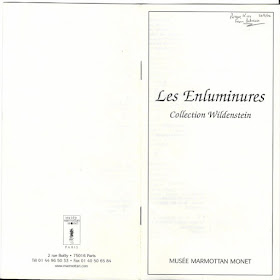On my way back from seeing the current exhibition of manuscripts in Rouen (perhaps the subject of a future post?), I visited the Musée Marmottan yesterday for the first time in about 20 years, to look at the Wildenstein leaves and cuttings, about which I've written several times before (e.g. here).
Overall, the visit was a disheartening experience: the lighting is about as bad as any exhibition I've ever seen: some items are in free-standing display cases under too-bright spotlights, but most are in wall vitrines with uneven and extremely low lighting, and, to make matters worse, the lighting is raking, as if deliberately to make every flaw and wrinkle of each leaf clearer!
I could not see much with the naked eye, although after about half an hour my eyes had adjusted enough that I could see a bit more. I probably could have taken useful photos -- digital cameras being very good at taking images in low light -- if it were not for the fact that all photography is banned throughout the museum.
A number of items are reproduced in a catalogue, however, and a few items are available as postcards, from one of which the image at the top of this post is scanned.
Since I last visited, the attributions were revised c.2001 by François Avril, Patricia Stirneman, et al., and a list was published in an undated booklet, a copy of which Patricia kindly sent me, but which appears to be out of print (I looked for it yesterday in the museum bookstore).
The cutting shown at the top and bottom of this post is attributed by Avril et al. to Richard de Montbaston, and regular readers will recognise the style and format from a recent post. A number of the Wildenstein cuttings and leaves were previously owned by Robert Forrer, and so I think it very likely that this one, too, was owned by him, and comes from the same Bible Historiale as the cuttings in Philadelphia, Enschede, Amsterdam, and elsewhere.
The subject of this cutting is uncertain (Avril et al. simply describe it as a "Banquet d'un roi"), and no text is visible to help. It is presumably from the Old Testament, perhaps King Ahasuerus banqueting at the beginning of the book of Esther: "In the third year of his reign, he made a feast unto all his princes and his servants" (Esther 1:3)? The feast of Ahasuerus is indeed the subject of the miniature at the beginning of the Book of Esther in at least a few other copies of the Bible historiale:
Edit, 6 Dec. 2019
The cutting was previously in the collection of R. Paris, sold by the Galerie Fischer, Luzern, Collection R. Paris, Nachlass eines Wiener Arztes, Gemälde, 30 August - 4 September 1937, lot 969:







No comments:
Post a Comment
** PLEASE INCLUDE YOUR NAME IN YOUR COMMENT **
I may ignore and delete anonymous comments